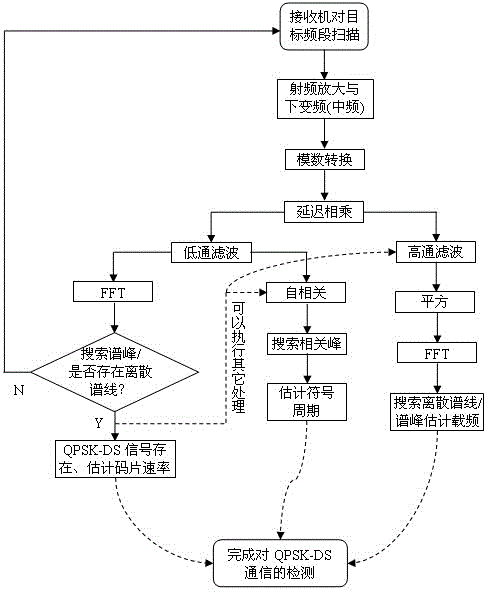QPSK-DS communication detecting method based on delay multiplication
A QPSK-DS, communication detection technology, which is applied in the field of QPSK-DS communication detection based on delay multiplication, can solve the problems of high computing power requirements of the receiver system, extremely difficult demodulation, and complex algorithm implementation, so as to reduce the system Sampling rate and data processing and storage capacity requirements, avoiding cross-mixing interference, and improving the effect of signal-to-noise ratio
- Summary
- Abstract
- Description
- Claims
- Application Information
AI Technical Summary
Benefits of technology
Problems solved by technology
Method used
Image
Examples
Embodiment Construction
[0027] In order to facilitate the understanding of the present invention, the present invention will be described in more detail below in conjunction with the accompanying drawings and specific embodiments. Preferred embodiments of the present invention are given in the description and drawings, but the present invention can be implemented in many different forms and is not limited to the embodiments described in the description. On the contrary, these embodiments are provided to make the understanding of the disclosure of the present invention more thorough and comprehensive.
[0028] It should be noted that when a certain element is fixed to another element, it includes directly fixing the element to the other element, or fixing the element to the other element through at least one other element in the middle. When an element is connected to another element, it includes directly connecting the element to the other element, or connecting the element to the other element through
PUM
 Login to view more
Login to view more Abstract
Description
Claims
Application Information
 Login to view more
Login to view more - R&D Engineer
- R&D Manager
- IP Professional
- Industry Leading Data Capabilities
- Powerful AI technology
- Patent DNA Extraction
Browse by: Latest US Patents, China's latest patents, Technical Efficacy Thesaurus, Application Domain, Technology Topic.
© 2024 PatSnap. All rights reserved.Legal|Privacy policy|Modern Slavery Act Transparency Statement|Sitemap

